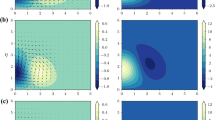Abstract
Whenever linear eigenmodes of open flows are computed on a numerical domain that is truncated in the streamwise direction, artificial boundary conditions may give rise to spurious pressure signals that are capable of providing unwanted perturbation feedback to upstream locations. The manifestation of such feedback in the eigenmode spectrum is analysed here for two simple configurations. First, explicitly prescribed feedback in a Ginzburg–Landau model is shown to produce a spurious eigenmode branch, named the ‘arc branch’, that strongly resembles a characteristic family of eigenmodes typically present in open shear flow calculations. Second, corresponding mode branches in the global spectrum of an incompressible parallel jet in a truncated domain are examined. It is demonstrated that these eigenmodes of the numerical model depend on the presence of spurious forcing of a local \(k^+\) instability wave at the inflow, caused by pressure signals that appear to be generated at the outflow. Multiple local \(k^+\) branches result in multiple global eigenmode branches. For the particular boundary treatment chosen here, the strength of the pressure feedback from the outflow towards the inflow boundary is found to decay with the cube of the numerical domain length. It is concluded that arc branch eigenmodes are artefacts of domain truncation, with limited value for physical analysis. It is demonstrated, for the example of a non-parallel jet, how spurious feedback may be reduced by an absorbing layer near the outflow boundary.
Similar content being viewed by others
References
Åkervik, E., Ehrenstein, U., Gallaire, F., Henningson, D.: Global two-dimensional stability measures of the flat plate boundary-layer flow. Eur. J. Mech. B/Fluids 27, 1–13 (2008)
Buell, J.C., Huerre, P.: Inflow/outflow boundary conditions and global dynamics of spatial mixing layers. In: Proceedings of 2nd Summer Program, Stanford University. Center Turbulence Research, pp. 19–27 (1988)
Cerqueira, S., Sipp, D.: Eigenvalue sensitivity, singular values and discrete frequency selection mechanism in noise amplifiers: the case of flow induced by radial wall injection. J. Fluid Mech. 757, 770–799 (2014)
Chakravarthy, R.V.K., Lesshafft, L., Huerre, P.: Global stability of buoyant jets and plumes. J. Fluid Mech. 835, 654–673 (2017)
Chomaz, J.-M.: Global instabilities in spatially developing flows: non-normality and nonlinearity. Annu. Rev. Fluid Mech. 37, 357–392 (2005)
Chomaz, J.-M., Huerre, P., Redekopp, L.G.: Bifurcations to local and global modes in spatially developing flows. Phys. Rev. Lett. 60, 25–28 (1988)
Coenen, W., Lesshafft, L., Garnaud, X., Sevilla, A.: Global instability in low-density jets. J. Fluid Mech. 820, 187–207 (2017)
Colonius, T.: Modeling artificial boundary conditions for compressible flow. Annu. Rev. Fluid Mech. 36, 315–345 (2004)
Couairon, A., Chomaz, J.-M.: Absolute and convective instabilities, front velocities and global modes in nonlinear systems. Physica D 108, 236–276 (1997)
Ehrenstein, U., Gallaire, F.: On two-dimensional temporal modes in spatially evolving open flows: the flat-plate boundary layer. J. Fluid Mech. 536, 209–218 (2005)
Ehrenstein, U., Gallaire, F.: Two-dimensional global low-frequency oscillations in a separating boundary-layer flow. J. Fluid Mech. 614, 315–327 (2008)
Garnaud, X., Lesshafft, L., Schmid, P.J., Huerre, P.: Modal and transient dynamics of jet flows. Phys. Fluids 25, 044103 (2013)
Heaton, C.J., Nichols, J.W., Schmid, P.J.: Global linear stability of the non-parallel Batchelor vortex. J. Fluid Mech. 629, 139–160 (2009)
Huerre, P.: Open shear flow instabilities. In: Batchelor, G.K., Moffatt, H.K., Worster, M.G. (eds.) Perspectives in Fluid Dynamics, pp. 159–229. Cambridge University Press, Cambridge (2000)
Huerre, P., Monkewitz, P.A.: Local and global instabilities in spatially developing flows. Annu. Rev. Fluid Mech. 22, 473–537 (1990)
Khorrami, M.R.: A Chebyshev spectral collocation method using a staggered grid for the stability of cylindrical flows. Int. J. Numer. Meth. Fluids 12, 825–833 (1991)
Kurz, H., Kloker, M.: Mechanisms of flow tripping by discrete roughness elements in a swept-wing boundary layer. J. Fluid Mech. 796, 158–194 (2016)
Lesshafft, L., Huerre, P.: Linear impulse response in hot round jets. Phys. Fluids 19(2), 024102 (2007)
Loiseau, J.-C., Robinet, J.-C., Cherubini, S., Leriche, E.: Investigation of the roughness-induced transition: global stability analyses and direct numerical simulations. J. Fluid Mech. 760, 175–211 (2014)
Marquet, O., Sipp, D., Jacquin, L.: Sensitivity analysis and passive control of cylinder flow. J. Fluid Mech. 615, 221–252 (2008)
Michalke, A.: Survey on jet instability theory. Prog. Aerosp. Sci. 21, 159–199 (1984)
Nichols, J.W., Lele, S.K.: Global modes and transient response of a cold supersonic jet. J. Fluid Mech. 669, 225–241 (2011)
Rodríguez, D., Cavalieri, A.V.G., Colonius, T., Jordan, P.: A study of linear wavepacket models for subsonic turbulent jets using local eigenmode decomposition of PIV data. Eur. J. Mech. B/Fluids 49, 308–321 (2015)
Sipp, D., Lebedev, A.: Global stability of base and mean flows: a general approach and its applications to cylinder and open cavity flows. J. Fluid Mech. 593, 333–358 (2007)
Trefethen, L. N., Embree, M.: Spectra and Pseudospectra: The Behavior of Nonnormal Matrices and Operators. Princeton University Press (2005). See also http://www.cs.ox.ac.uk/projects/pseudospectra/
Acknowledgements
Discussions with Xavier Garnaud and Wilfried Coenen greatly helped shape the ideas presented in this paper. The study was supported by the Agence Nationale de la Recherche under the Cool Jazz project, Grant Number ANR-12-BS09-0024.
Author information
Authors and Affiliations
Corresponding author
Additional information
Communicated by Sergio Pirozzoli.
Rights and permissions
About this article
Cite this article
Lesshafft, L. Artificial eigenmodes in truncated flow domains. Theor. Comput. Fluid Dyn. 32, 245–262 (2018). https://doi.org/10.1007/s00162-017-0449-6
Received:
Accepted:
Published:
Issue Date:
DOI: https://doi.org/10.1007/s00162-017-0449-6




